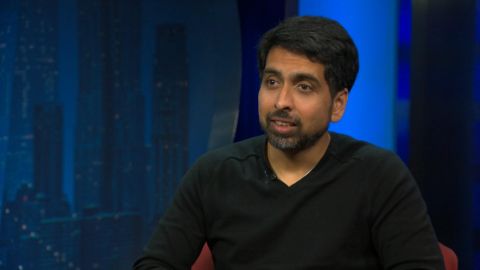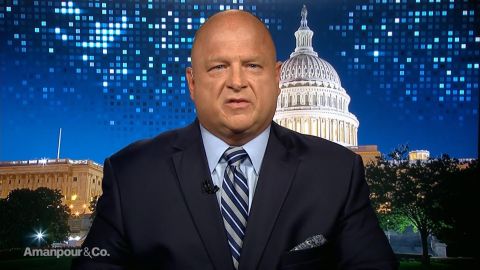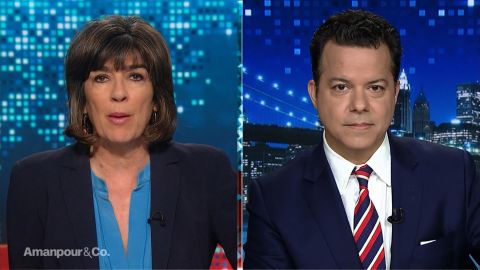Read Transcript EXPAND
CHRISTIANE AMANPOUR: And for now, let us break away from what will be days of further analysis and let’s learn more about, well, learning. Sal Khan only wanted to help his cousin with her math when he started posting educational videos online. Not too long after that he began the Khan Academy. That was 2008. 11 years later, it has some 5 million subscribers on YouTube, and it reaches across the globe. The nonprofit’s goal is to give a free world-class education for anyone, anywhere. It’s a lofty aim to be sure and the academy’s founder, Sal Khan, sat down with our Walter Isaacson to talk about how he’s going to achieve that goal.
WALTER ISAACSON: Sal, thank you for being on the show.
SAL KHAN, FOUNDER & CEO, “KHAN ACADEMY”: Great to be here.
ISAACSON: This college admissions scandal. I mean, there’s so many unnerving things about it, but it again taught us how unleveled the playing field is for getting into college.
KHAN: Well look, the scandal itself, there is a silver lining because this wasn’t kind of legal unleveling the playing field, this is just outright illegal behavior. And I think the silver lining is it’s going to create a nice chill on some of this gray area behavior that wasn’t clear whether it’s legal or illegal, where you have these, you know, high-priced consultants that are editing essays or crafting student profiles.
So, I think in some ways the fact that this came out will level things a little bit. But to your point, it does highlight how many resources are being thrown at this desire by a lot of families to — you know, we all care about our children, we all want the best for our children. But when you have resources — obviously these folks were trying illegal avenues, but there are actually fairly legal avenues that will create a disparity. And a lot of what we focus at Khan Academy is to — as much as possible, how do we level the playing field, especially in something that we all — we all desire to have a meritocracy, or at least we all say that. How do we actually create it?
ISAACSON: When you started Khan Academy, it was part of an explosion of what became known as MOOCs in the college level, which are massive online open courses ,and people can do online learning and there was all sorts of form, from Harvard acts to Coursera to whatever. And that — the excitement around that in so many layers has dissipated. What do you see the more general future of online learning being?
KHAN: Yes, I think — I think most waves — what happens is it starts and people get really excited about them and they — they assume that, you know, in two years the whole world will be different. And then that doesn’t happen and they say, “oh, well, maybe nothing happened.” But actually, things are happening quite quickly. You know, Khan Academy, last number I checked from — from — from folks who did some survey data, 70 percent of all American kids used it at least once last year. You know, as a nonprofit, our budget’s the budget of a — of a large high school but we — we reach over 100 million kids every year.
And I know a lot of other — some of these other nonprofits like edX, you have many millions of people who are starting to upskill themselves. I think in about four or five years — and I tell them to the team every day — Khan Academy has kind of three phases. Phase one was me in a walk-in closet, trying to convince the world that this was a legitimate activity. Phase two was Khan Academy being a real organization, and really scaling to millions and running the efficacy studies and showing that this — this is a real way that we can move the dial. And then phase three is the phase that we’re entering now, where we — we actually do want to move the dial for states and for countries.
And I think you’re going to start seeing that over the next — the next few years. And I think you’ll also see some of the — the — the tangential parts to the learning piece start to come into focus over the next four or five years around credentialing, around alternative paths through college, alternative ways to get into the workforce, alternative ways to get an internship or whatever else.
ISAACSON: So what other than college could be the signaling mechanism for saying you can get a good job in the future?
KHAN: Well one thing that I’m fascinated by is this — this notion that even if you have a college degree and you go searching for a job, you’ll send your resume out to 30 or 40 places and then if the folks that want to interview you, then they’ll put you through a whole battery of interviews and then maybe out of those 30 or 40, if you’re lucky enough, you’ll get one job. I can imagine a world where you’re able to on one level prove your competencies, your academics, your skills — and that could be things you do on Khan Academy, it could be things that you do on the job, you document your portfolio of things you’ve made, and that that interview could happen once, where it’s done in a very professional way by experts that know what the best practices are and it’s documented.
And so employers don’t have to do a lot of that themselves, where that one interview they can go see how you did and you get as many times as you need to re-do it as you get more skills — it’s like wait, I have a better answer to that question about my — my weakness or whatever it is. And that process happens every three to five years as people transition to a new job. And probably with all of the change we’re seeing over the next 10, 20, 30 years, with potentially dislocation due to technology, I think there are ways where we can create really robust signals of skill level competency, of social emotional capabilities, of leadership capabilities that actually would be a more robust signal than today’s credentials.
ISAACSON: You created something that’s a physical school after you had done khan academy so you could see how schools work with real people in the physical space. What did you learn about the role of the teacher and what’s irreplaceable about the actual physical flesh and blood teacher in a classroom?
KHAN: Yes, a lot of people find it ironic that about five years ago, you know, I wrote the book “One World Schoolhouse” and in that I kind of talk about, OK, now that we have these tools, what could education be? Well now that students can get lectures at their own time and pace, does class time have to focus on lectures? And if class time doesn’t have to focus on lectures, why do we have to move everyone at a fixed pace? If you don’t have to move everyone at a fixed pace, well why do you have to separate kids by perceived ability level?
If you don’t have to do it by that, why even separate kids by age? And then while you’re at it, why should you have this very clear distinction between when school is in session and school is out of session? Even the whole system comes out of en agrarian system where kids needed to work on the farms and it assumed that a mother was at home who didn’t have to work at 3 o’clock to help out with your kids, whatever. All of that stuff isn’t true anymore. And so, I wrote at length about what could credentials of the future look like, what could a school of the future look like. But it’s one thing to theorize about it, it’s a whole other thing to create it and to live it.
And so about five years ago we created Khan Labs — it’s literally in the same building as Khan Academy — to test these ideas. Multi-age classrooms, which does hearken back — that’s why I always call it back “One World Schoolhouse,” harkens back to the one room schoolhouse. Have master-based learning, competency-based learning where students advanced based on their — their — their skill set versus sitting in a seat. I mean, I always point out we just take it for granted in colleges today it’s the number of credit hours. They’re not saying what you know, they’re saying how many hours you have to sit in a chair that week and they accumulate it at some point to a degree.
What could the portfolio of the future — or the transcript of the future look like, where it’s your portfolios, it’s your competencies, it’s some peer evaluation of who you are. And so we’ve been doing that the last five years and we’re really seeing when you’re allowing students to learn at their own time and pace and you have really caring people around, especially really caring adults around, that all students benefit. You know, one of the fears of personalized learning is that, oh, maybe just the motivated kids are just going to race ahead and leave everyone else behind.
But we’re seeing the — the opposite, that a lot of the kids at our school that started off in the bottom quartile — we have no I.Q. test or anything to get into the school — they start in the bottom quartile, after four years or so, they’re all operating in the top quartile. It shows that you can really pull these kids ahead.
ISAACSON: And do you think it’s important to have smaller class size or do you think technology allows us to have larger classes?
KHAN: I think all else equal, the smaller the class size the better. You know, the gold standard will always be a one-on-one amazing tutor. I think it’ll be a very long time before technology can compete with that. That’s just not practical. So in any of these debates, smaller class size is for sure better. But wherever the class size happens to land in a specific geography, we want to help those educators be able to mimic a smaller class size by allowing them to cater to the needs of individual students.
ISAACSON: How are you curricular vetted? I mean, in some ways you just were winging it. You admitted you were winging it early on and yet teachers have a pretty clear and strict method of teaching. How did yours get vetted and why is yours valid?
KHAN: So in the early days of Khan Academy, when it was with my cousins — or you know, this was back in now 2007, 2008, it was –yes, it was me just kind of intuiting what I thought would be valuable for my cousins and other people’s cousins. And then, you know, people would send me requests and — and one of the values that I think I was able to give at that time, and hopefully still give, is as someone who got through the system and I did not have a lot of those debilitating gaps that kept me from advancing in math or science, I felt that what really helped me is that I — I got how all of these things fit together.
When I learned a new concept in math, I was like, oh, that’s kind of just like the concept we learned last year with a slight variation and that connects to what I just did in physics class. And so I tried to do that for my cousins, where they saw that math and science was really just a really connected way of describing this incredibly beautiful universe. And I think other people really resonated with that. Now once we became a — I guess you could say a real organization and we started getting philanthropic funding, then we said let’s look at the major standards, let’s make sure we cover them.
We have a flair large team in-house and these are content experts, former teachers, researchers, who are looking at the standards, thinking aboutwhat we have, how can we cover it best? We look at the data where we can see for any one of our either practice items or for our lessons, is it effective for students or is it not? Is it being used or is it not? Is it engaged or not?
And we’re constantly iterating on that, and we also have third party evaluators. So, for example, when we work on the SAT material, the people who make the assessment are evaluating it. When we work on, say, material for the common core, we have some of the folks who are involved in developing the common core who are able to vet this material. And that’s one of the values we’re able to give is that every teacher can’t have that luxury of someone who wrote the common core being able to look at your lesson plan and say hey oh yes, this is what we meant by that standard, not this, while we are able to do that and then that helps teachers not have to worry about that aspect as much.
ISAACSON: Is there a worry that the district will use this as a cheap and easier way than actually hiring more teachers and training more teachers so that people who are underprivileged loose that personal touch of a great teacher and school districts can just use automation to do the teaching?
KHAN: My view on education in particular — in fact the whole automation to me, it’s a whole other element why the education is so important, but in my mind, the single biggest factor in a student’s life is that teacher. And everything, and I’m always telling the team at Khan academy this, we’re not out there to use technology for technology sake, there’s a lot of technologists who will create a solution and then be in search of a problem for that solution, we don’t view ourselves that way, we view ourselves as really a — what — how do we create a world where students are able to learn at a pace, at a level that is more appropriate for them, how do we create a world where the human teachers are able to cater to what the students need?
And it could be academic support, it might be emotional support for what the student needs, and if the right tool is chalk, the right tool is chalk. If the right tool is paper, it’s paper. If the right tool is adaptive software that can adapt to the students pace and give the teacher data and analytics and dashboard so that they can really focus their instruction, then that’s the right tool.
ISAACSON: Some people say we’re over testing our kids and over assessing the kids, do you feel there’s a better way than the standardized tests?
KHAN: You know, sometimes when people are anti standardized testing I always say, well what’s the alternative, would you prefer non-standardized testing? Or no testing at all? And so normally they go “oh yes of course,” but the real problem people have with testing and standardized testing is when it’s not used in a positive way. So, in traditional schools right now, at the end of the year you usually have your state tests, kids take the state tests and you don’t usually get the data until the very end of the school year or even the summer, and then by that time, the kids are out of school or then they show up at school the next fall and they have a different teacher.
And then that teacher gets the data and she sees that wow half of my kids on last years state test weren’t even at a sixth grade level, but I got to cover the seventh grade material so she’s going to try her best to do it, but the test wasn’t that useful. I mean, I still have too — I’m still going to do the same action that I would of even if I had no testing data. So, taking the time to do the testing, and all of that time and cost and humans and resources, if you’re not going to be able to do anything useful with it for the students or for the teachers, well then it is a legitimate question.
ISAACSON: Teachers are going on strike everywhere from California to West Virginia, what do you think is behind that, and what should we be doing?
KHAN: Well, I’m not an expert but I think they have legitimate concerns. My understanding of the L.A. teacher strike is teachers were concerned about large class sizes where they’re not able to meet the needs of every student, they are frankly more concerned about issues like that than even their own pay — pay was definitely a factor, especially in costly places where teachers, which are doing — you know this isn’t just a cliché, literally the most important work in our society, are having trouble living in the same communities where they’re teaching.
These are very legitimate things. And then you — and they’re doing heroic things with whatever time and resources they’re being given. So I 100 percent empathize with where they are, at the same time I also get where there the districts have tons of constraints, where are they going to get the resources, so I think as a society, how seriously do we take being able to upscale all students, especially as we get into this wave where technology and automation are going to make it more imperative that kids don’t even just have the basics of the three R’s so to speak, but they’re able to operate at a much higher level so that they’ll never be able to be replaced by an artificial intelligence, and so on one level the economy and society’s going to be asking even more and more from our education system, and in theory all of this technology’s going to create wealth that could be used, and so I think as a society we have to ask ourselves, are we willing to make that investment.
ISAACSON: Sal, thanks for being with us.
KHAN: Appreciate it, Walter.
About This Episode EXPAND
Christiane Amanpour speaks with John Avlon, David Urban and Sean Wilentz about the Mueller report. Walter Isaacson speaks with Sal Khan about Khan Academy.
LEARN MORE



